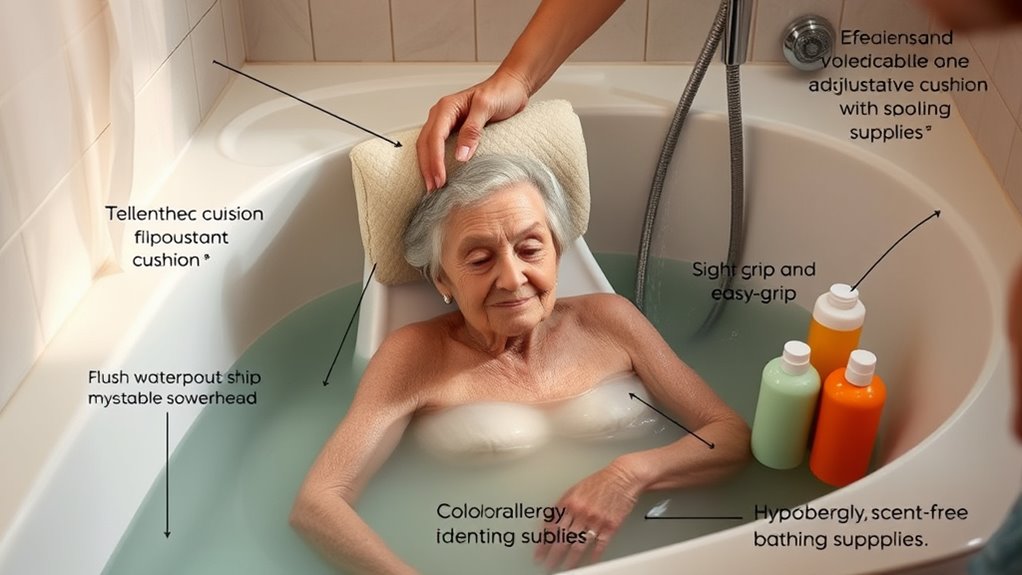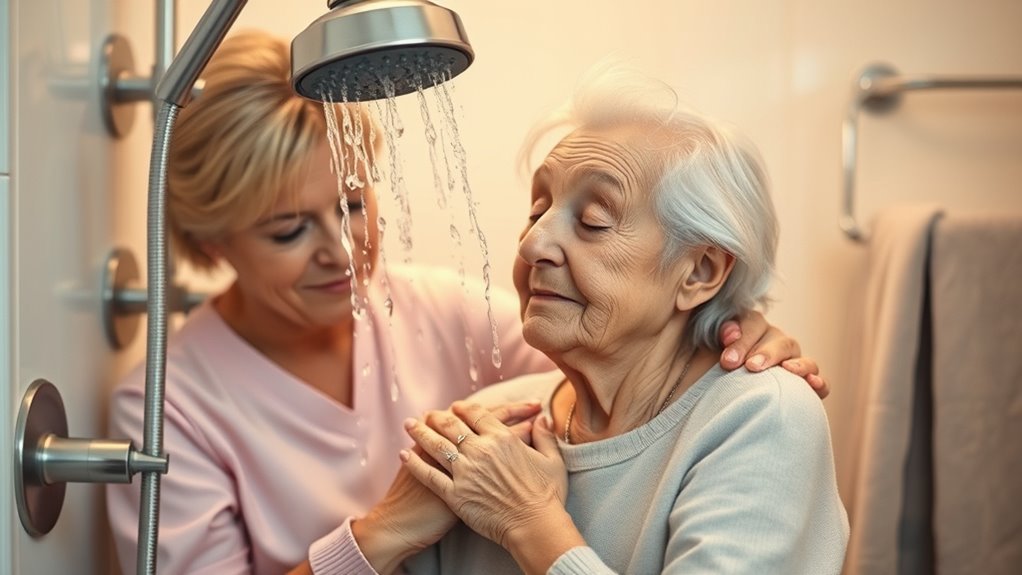To bathe a loved one with Alzheimer’s without battles, create a calm, predictable routine by establishing a consistent schedule and gentle communication. Prepare the environment with soft lighting, familiar scents, and safe, accessible supplies. Use reassurance, simple words, and respectful gestures to foster trust. Keep safety measures like grab bars and non-slip mats in place. Staying patient and attentive to signs of distress will help make bath time smoother. If you keep going, you’ll discover more helpful techniques.
Key Takeaways
- Establish a consistent, predictable routine with visual cues to reduce confusion and resistance during bathing.
- Create a calming environment with soft lighting, familiar scents, and gentle water temperature to ease anxiety.
- Use respectful communication, reassurance, and patience to foster trust and minimize agitation.
- Prepare all supplies beforehand and keep essentials within easy reach to prevent surprises and frustration.
- Incorporate non-slip mats, supportive fixtures, and safety features to ensure comfort and prevent accidents.
Understanding the Challenges of Bathing With Alzheimer’S

Bathing can be one of the most difficult tasks for people with Alzheimer’s, as the disease affects memory, communication, and sensory perceptions. You might notice they forget what to do next or become confused about why they’re in the shower or bathtub. They may resist water or become anxious because the sensory experience feels overwhelming or unfamiliar. Changes in communication make it hard for them to express discomfort or needs, leaving you unsure how to help. Sometimes, they might feel disoriented or frightened during bath time, which increases resistance. Their perception of temperature, touch, or even safety can be altered, making the process unpredictable. Recognizing sensory sensitivities associated with Alzheimer’s can guide you in creating a calmer, more comfortable bathing environment. Additionally, understanding how visual perception affects their interaction with the environment can help you adapt the space for better comfort and safety. Being aware of lighting conditions can further reduce confusion and agitation during bathing, making the experience more manageable for both caregiver and individual. Incorporating environmental modifications, such as using soft lighting and minimizing clutter, tailored to sensory needs can significantly improve the bathing experience and reduce distress.
Preparing the Environment for a Calm Bathing Experience

Creating a calm bathing environment starts with simple adjustments that can make a big difference. You can use soft lighting to reduce glare and create a soothing atmosphere, while maintaining a gentle water temperature to prevent discomfort. Additionally, familiar bath items help establish a sense of security and familiarity during the experience. Incorporating sustainable materials in bath accessories can also promote an eco-friendly environment, aligning with broader wellness and ethical considerations. Using specialized bath products designed for sensitive skin can further enhance comfort and safety during bathing. Selecting environmentally conscious products can further support sustainable living and reduce ecological impact. Being mindful of product safety standards ensures that the bath items used are both safe and reliable for individuals with Alzheimer’s. Incorporating eco-friendly and safe materials in bath items can help reduce potential irritants and promote overall well-being.
Soft Lighting Choices
Soft lighting plays a essential role in setting a calming atmosphere during bath time, especially for individuals with Alzheimer’s. Gentle lighting reduces shadows and glare, preventing overstimulation and helping your loved one feel safe. Use dimmable lights or lamps with warm bulbs to create a soothing environment. Avoid harsh, bright overhead lighting that can cause discomfort or confusion. Position lights so they provide enough visibility without being overwhelming. Consider using night lights or small lamps near the bath area for additional comfort. This soft lighting helps reduce anxiety, making the experience smoother for both of you.
- Use dimmable or warm-colored bulbs
- Avoid bright, overhead lights
- Position lights to minimize shadows
- Incorporate night lights for guidance
- Keep lighting consistent and gentle
Gentle Water Temperature
Ensuring the water temperature is gentle and comfortable can make a significant difference in creating a calm bathing experience. You want the water to feel soothing, not startling or too hot. Aim for around 98°F to 102°F (37°C to 39°C), similar to body temperature. Test the water with your wrist or elbow before starting. Keep the temperature consistent to avoid sudden changes that might unsettle your loved one. Use a thermometer if needed to ensure accuracy. Here’s a quick visual guide:
| Temperature Range | Sensory Effect | Comfort Level |
|---|---|---|
| 95°F – 97°F | Slightly cool, rejuvenating | Mildly soothing |
| 98°F – 102°F | Warm, comfortable | Most relaxing |
| 103°F – 105°F | Hot, potentially uncomfortable | Less desirable |
| Above 105°F | Too hot, risky for burns | Avoid |
This careful approach helps create a peaceful, safe bathing environment.
Familiar Bath Items
Using familiar bath items can substantially ease your loved one’s anxiety and make the experience more comforting. When they recognize their belongings, it creates a sense of safety and reduces confusion. Keep items like their favorite sponge, familiar shampoo, or a preferred towel within easy reach. Using the same soap or lotion they enjoy can also provide reassurance. This consistency helps them feel more at ease during bath time.
- Their favorite towel or bathrobe
- A familiar, gentle soap or shampoo
- A specific sponge or washcloth they prefer
- A calming scent they associate with comfort
- A familiar cup or container for rinsing
These small touches can turn bath time into a more relaxed and positive routine for both of you.
Establishing a Consistent Routine and Schedule

Creating a consistent bath time helps your loved one feel more secure and aware of what to expect. When you stick to a regular schedule, it reduces confusion and anxiety during the process. Following structured steps also makes the experience calmer and more manageable for both of you. Incorporating a structured routine and reliable, compassionate resources into your routine can provide additional support and guidance when needed. Using appropriate adaptive tools can further enhance comfort and safety during bathing. Additionally, understanding brewing methods can inspire you to create a calming environment, such as using gentle lighting or soothing background sounds, to help relax your loved one during bath time. Being aware of signs of spoilage in products like lemon juice can remind caregivers to ensure all items used are fresh and safe, contributing to a healthier bathing environment.
Consistent Timing Benefits
Establishing a consistent routine for bathing helps reduce confusion and anxiety for individuals with Alzheimer’s. When timing stays predictable, your loved one begins to anticipate the activity, which lowers resistance and agitation. Consistent timing also reinforces a sense of security, making the process smoother. It helps both of you stay organized, reducing surprises that can trigger upset. Over time, the person becomes familiar with when bathing occurs, creating a calming rhythm. This predictability minimizes resistance, making the experience more peaceful.
- Set the same time each day or week for bathing
- Use cues like a clock or calendar to signal routine
- Prepare everything beforehand to avoid delays
- Keep the environment calm and quiet
- Be patient if schedule needs slight adjustments
Structured Steps Ease Anxiety
When you set a consistent routine and schedule for bathing, it can considerably reduce your loved one’s anxiety. Knowing what to expect helps them feel secure and less confused. Establish a step-by-step process to guide each bath, making it predictable and calm. For example, you might prepare supplies, help with clothing, and then proceed to washing, all in the same order. Use a visual or physical cue to signal each step, reinforcing familiarity. Here’s an example of a routine:
| Step | Action |
|---|---|
| 1 | Gather supplies |
| 2 | Help with clothing removal |
| 3 | Wash body gently |
| 4 | Rinse thoroughly |
| 5 | Dry and dress |
This structure creates a calming rhythm, easing anxiety and making baths more manageable.
Using Gentle Communication and Reassurance Techniques

Using gentle communication and reassurance techniques can make a significant difference in easing a person with Alzheimer’s during bathing. Speak calmly, using simple sentences and a soothing tone to reduce anxiety. Maintain eye contact and use their name to create a sense of connection. Reassure them frequently, reminding them that they are safe and cared for. Avoid arguing or correcting, and instead, validate their feelings. Offer gentle touch when appropriate, and stay patient if they become confused or resistant. These strategies help build trust and create a calming environment. Incorporating familiar routines and consistency can also help reduce confusion and increase comfort during bathing. Additionally, understanding individual preferences and tailoring approaches can enhance cooperation and reduce stress. Engaging in somatic therapy techniques, such as mindful breathing or gentle movement, may also help both caregivers and individuals feel more relaxed and connected during these moments. Being aware of resources and tools available can further support caregivers in managing these sensitive situations effectively. Maintaining a comfortable environment with appropriate lighting and temperature can also lessen agitation and promote relaxation during bathing.
Selecting the Right Supplies and Tools for Ease and Comfort

Choosing the right supplies and tools can make bathing a smoother experience for both you and your loved one with Alzheimer’s. Start with non-slip mats to prevent falls and easy-grip handles on shampoo bottles and soap dispensers for better control. Use gentle, fragrance-free products designed for sensitive skin, reducing irritation and discomfort. A handheld showerhead allows you to control water flow and avoid surprises, making the process more manageable. Consider waterproof or easily washable bathing cloths that are soft and comfortable. Keep towels, washcloths, and supplies within arm’s reach to minimize movement and distractions. Utilizing HEPA filtration in the environment can help reduce airborne irritants and allergens, creating a healthier bathing atmosphere. Incorporating calm environments that minimize noise and visual clutter can also significantly reduce anxiety during bath time. Creating a safe bathing space with secure fixtures and supportive surfaces can further enhance safety and confidence during bathing. Investing in supplies that are simple, safe, and comfortable helps create a calm, predictable environment, easing anxiety and making bath time more manageable for everyone involved. Additionally, utilizing necessary cookies can help ensure your browsing experience remains smooth and secure during this process. Recognizing the importance of a well-organized and remote work friendly setup can also contribute to maintaining patience and composure during caregiving routines.
Approaching Bathing With Patience and Empathy

When you approach bathing with patience and empathy, you create a calmer experience for your loved one. Use gentle words and respectful gestures to ease their anxiety and build trust. Staying consistent and honoring personal boundaries helps make the process smoother for both of you.
Gentle Communication Strategies
Approaching bathing with patience and empathy can transform a potentially stressful experience into a calming routine. Your gentle words and calm tone help reduce anxiety and build trust. Use simple, reassuring language like “We’re almost done,” or “You’re doing great.” Maintain eye contact and smile gently to convey understanding. Listen carefully to their responses, and avoid rushing or arguing. Focus on their comfort, and be mindful of non-verbal cues indicating distress. Consistency in your approach creates a sense of familiarity. Remember, your calm demeanor can soothe agitation and foster cooperation.
- Speak softly and clearly
- Use reassuring phrases
- Maintain a calm, steady tone
- Be attentive to non-verbal cues
- Offer gentle, encouraging feedback
Respecting Personal Boundaries
Building trust during bathing starts with respecting your loved one’s personal boundaries. You should always ask for permission before touching or moving them, and pay close attention to their comfort levels. Respect their choices, even if they refuse or seem uncomfortable, and never force them into the bath. Use gentle words and a calm tone to reassure them, making it clear you value their feelings. Be mindful of sensitive areas, and avoid rushing through the process. If they become overwhelmed, take a break and try again later. By honoring their personal space and listening to their cues, you create a safer, more respectful environment. This approach helps reduce anxiety and builds a foundation of trust that makes bathing less stressful for both of you.
Patience and Consistency
Because patience and empathy are essential, maintaining a calm and gentle demeanor can make a significant difference during bath time. When you approach the task with consistency, your loved one feels safer and more comfortable. Rushing or showing frustration can increase resistance, so take your time and stay reassuring. Speak softly and use familiar phrases to create a sense of trust. Establish a routine that stays the same each time, helping your loved one know what to expect. Remember, progress may be slow, but your steady attitude fosters cooperation.
- Use a gentle tone and slow movements
- Stick to a familiar bathing routine
- Offer reassurance throughout the process
- Be flexible and patient with delays
- Celebrate small successes to boost confidence
Incorporating Distractions and Comfort Measures

Incorporating distractions and comfort measures can substantially ease the bathing process for individuals with Alzheimer’s. Using calming music, gentle conversation, or familiar objects can divert their attention and reduce anxiety. Consider dimming the lights or playing soothing sounds to create a relaxing environment. You might also offer a favorite towel or bathrobe to provide a sense of familiarity and security. Some people respond well to aromatherapy with calming scents like lavender. Keep the water at a comfortable temperature and speak softly to reassure them throughout the process. By engaging their senses and providing comfort, you help create a more peaceful experience. These small adjustments can make a significant difference, transforming bath time from a stressful ordeal into a more manageable routine.
Ensuring Safety While Promoting Independence

Creating a safe bathing environment while encouraging independence involves balancing support with trust. You want your loved one to feel empowered, yet protected from falls or injuries. To do this, assess the bathroom for hazards like slippery floors or sharp edges. Install grab bars and non-slip mats to provide stability. Keep essentials within easy reach to avoid unnecessary stretching or bending. Use a shower chair if needed, but ensure it’s sturdy and properly positioned. Maintain clear pathways to prevent trips, and consider temperature controls to avoid burns. Remember to communicate clearly, involve your loved one in decisions, and respect their autonomy as much as possible. These steps foster confidence while minimizing risks, making bathing a safer, more respectful experience.
- Secure grab bars and non-slip mats
- Keep bath supplies within reach
- Use a sturdy shower chair if needed
- Clear pathways to prevent trips
- Set water temperature controls
Recognizing and Responding to Signs of Distress

Recognizing when your loved one is distressed during a bath is essential for ensuring their safety and comfort. Look for signs like tense muscles, clenched fists, or attempts to pull away. Changes in facial expressions, such as frowning or crying, can also indicate discomfort. If they become agitated, restless, or verbally upset, these are clear signals they’re overwhelmed. Pay attention to their breathing; rapid or shallow breaths suggest distress. Respond promptly by speaking softly, offering reassurance, or pausing the process to check in. Sometimes, simply giving them a break or adjusting the environment can help ease their anxiety. Your attentive response not only calms them but also prevents escalation, making bathing a safer, more positive experience.
Tips for Caregivers to Manage Stress During Bathing

Managing your own stress while bathing a loved one with Alzheimer’s can be challenging, but staying calm and focused makes a significant difference. When you’re relaxed, your loved one feels safer, making the process smoother. Take deep breaths to stay centered, and remind yourself it’s okay to take breaks if needed. Keep your tone gentle and reassuring to reduce tension. Setting a calm environment can help, like playing soft music or ensuring the room is warm. Remember to speak slowly and clearly, and use simple instructions.
- Prepare everything in advance to avoid rushing
- Use calming words and a soothing tone
- Take short breaks if either of you becomes overwhelmed
- Keep the bathroom warm and comfortable
- Practice deep breathing exercises before starting
Frequently Asked Questions
How Can I Handle Resistance to Bathing From a Reluctant Loved One?
When your loved one resists bathing, try to understand their feelings and find gentle ways to ease their fears. Offer choices, like selecting their soap or towel, to give them some control. Keep the environment calm and comforting, and use distraction or humor if appropriate. Remember, patience is key—slow down and show empathy, making the experience as positive as possible to reduce resistance and create a more peaceful routine.
Are There Specific Bath Aids for Individuals With Advanced Alzheimer’S?
Did you know that nearly 70% of caregivers report bathing as a challenging task? For individuals with advanced Alzheimer’s, specialized bath aids can make a huge difference. You might consider non-slip mats, long-handled sponges, or waterproof gloves to help them feel secure and comfortable. These tools minimize discomfort and safety risks, making the process smoother for both of you. Using the right aids can turn a stressful routine into a more manageable experience.
How Do I Address Bathing Refusals Without Causing Distress?
When your loved one refuses to bathe, stay calm and patient. Gently remind them of the importance of hygiene without arguing, and try to make the process feel less overwhelming. Use distractions or incorporate their favorite scents or music to create a relaxing atmosphere. Offer choices, like the timing or type of bath, to give them a sense of control. Your calm, reassuring approach helps reduce distress and encourages cooperation.
What Are Signs That a Person Is Overwhelmed During Bathing?
Imagine your loved one is a delicate flower, easily overwhelmed. Signs they’re overwhelmed during bathing include tense muscles, rapid breathing, and avoiding eye contact. They may become agitated, verbally upset, or try to pull away. You might notice trembling or a sudden change in facial expression. Recognizing these signals helps you step back, create a calmer environment, and guarantee their comfort, preventing further distress during the process.
How Can I Involve the Person With Alzheimer’S in the Bathing Process?
To involve someone with Alzheimer’s in the bathing process, start by explaining what you’re about to do in simple terms. Use their favorite towel or bathrobe to make it more familiar. Let them hold a washcloth or choose their scent soap if possible. Keep the environment calm, speak gently, and give them some control, like rinsing or drying, so they feel engaged and respected throughout.
Conclusion
By creating a calm, consistent bathing routine, you can reduce stress for both you and your loved one with Alzheimer’s. Remember, almost 60% of caregivers say bathing is one of the most challenging tasks, so patience and gentle reassurance are key. With the right environment, communication, and safety measures, you can make bath time a peaceful experience that preserves dignity and promotes well-being for your loved one.









